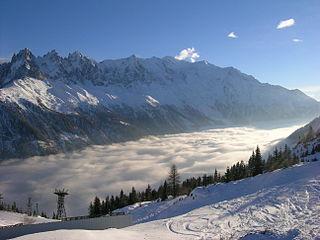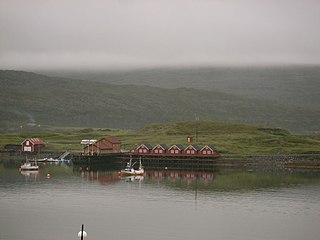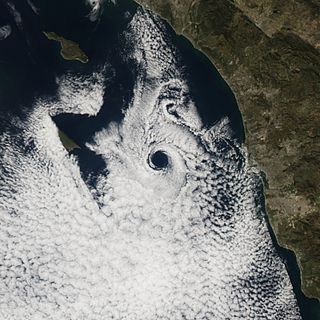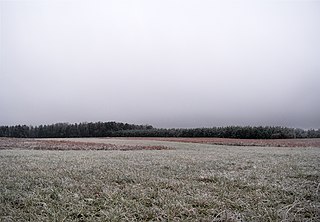
In meteorology, a cloud is an aerosol consisting of a visible mass of minute liquid droplets, frozen crystals, or other particles suspended in the atmosphere of a planetary body. Water or various other chemicals may compose the droplets and crystals. On Earth, clouds are formed as a result of saturation of the air when it is cooled to its dew point, or when it gains sufficient moisture from an adjacent source to raise the dew point to the ambient temperature. They are seen in the Earth's homosphere. Nephology is the science of clouds, which is undertaken in the cloud physics branch of meteorology.

A nimbostratus cloud or nimbostratus is a low, gray, often dark, amorphous, nearly uniform cloud that usually produces continuous rain, snow, or sleet and no lightning or thunder.

Cirrostratus is a high-level, very thin, generally uniform stratiform genus-type of cloud, composed of ice-crystals. It is difficult to detect and is capable of forming halos when the cloud takes the form of thin cirrostratus nebulosus. The cloud has a fibrous texture with no halos if it is thicker cirrostratus fibratus. On the approach of a frontal system, the cirrostratus often begins as nebulosus and turns to fibratus. If the cirrostratus begins as fragmented fibratus it often means the front is weak. Cirrostratus is usually located above 5.5 km (18,000 ft). Its presence indicates a large amount of moisture in the upper atmosphere.

A sea of clouds is an overcast layer of clouds, viewed from above, with a relatively uniform top which shows undulations of very different lengths resembling waves. A sea of fog is formed from stratus clouds or fog and does not show undulations.

The Chrysler Cirrus is a mid-sized 4-door notchback sedan introduced by Chrysler motors for the 1995 model year. Built on the Chrysler JA platform, the 4-door notchback sedan joined Chrylser's roster of "Cloud Car" models drawing their names names from meteorological terms, including the mid-priced Dodge Stratus it was based on introduced at the same time, and the low-priced Plymouth Breeze variant a year later.

June Gloom is a Southern California term for a weather pattern that results in cloudy, overcast skies with cool temperatures during the late spring and early summer. While it is most common in the month of June, it can occur in surrounding months, giving rise to other colloquialisms, such as "May Gray", "No Sky July", and, rarely, "Fogust". Low-altitude stratus clouds form over the cool water of the California Current, and spread overnight into the coastal regions of Southern California. The overcast skies often are accompanied by fog and drizzle, though usually not rain. June Gloom usually clears up between mid-morning and early afternoon, depending on the strength of the marine layer, and gives way to sunny skies. On a strong June Gloom day, the clouds and fog may extend inland to the valleys and Inland Empire and may persist into the mid-afternoon or evening.

The Dodge Stratus is a mid-size car that was introduced by Dodge in February 1995, and was based on the 4-door sedan Chrysler JA platform. The Stratus, Plymouth Breeze, and Chrysler Cirrus were all on Car and Driver magazine's Ten Best list for 1996 and 1997. It received critical acclaim at launch, but ratings fell over time. An updated version of the Stratus was introduced for 2001, with the Cirrus being renamed as the Chrysler Sebring, and a coupé model was also added to the range. However, production ended at the Sterling Heights Assembly Plant in early 2006 which had built 1,308,123 Stratus and Sebrings since 2000. The Dodge Avenger replaced the Stratus nameplate in early 2007 for the 2008 model year.

Cumulus mediocris is a low to middle level cloud with some vertical extent of the genus cumulus, larger in vertical development than Cumulus humilis. It also may exhibit small protuberances from the top and may show the cauliflower form characteristic of cumulus clouds. Cumulus mediocris clouds do not generally produce precipitation of more than very light intensity, but can further advance into clouds such as Cumulus congestus or Cumulonimbus, which do produce precipitation.

Fractus clouds (scuds) are small, ragged cloud fragments that are usually found under an ambient cloud base. They form or have broken off from a larger cloud, and are generally sheared by strong winds, giving them a jagged, shredded appearance. Fractus have irregular patterns, appearing much like torn pieces of cotton candy. They change constantly, often forming and dissipating rapidly. They do not have clearly defined bases. Sometimes they are persistent and form very near the surface. Common kinds include scud and cloud tags.
Snow grains are a form of precipitation. Snow grains are characterized as very small (<1 mm), white, opaque grains of ice that are fairly flat or elongated.
Unlike snow pellets, snow grains do not bounce or break up on impact. Usually, very small amounts fall, mostly from stratus clouds or fog, and never fall in the form of a shower.

A marine layer is an air mass which develops over the surface of a large body of water such as the ocean or large lake in the presence of a temperature inversion. The inversion itself is usually initiated by the cooling effect of the water on the surface layer of an otherwise warm air mass. As it cools, the surface air becomes denser than the warmer air above it, and thus becomes trapped below it. The layer may thicken through turbulence generated within the developing marine layer itself. It may also thicken if the warmer air above it is lifted by an approaching area of low pressure. The layer will also gradually increase its humidity by evaporation of the ocean or lake surface, as well as by the effect of cooling itself. Fog will form within a marine layer where the humidity is high enough and cooling sufficient to produce condensation. Stratus and stratocumulus will also form at the top of a marine layer in the presence of the same conditions there.

Overcast or overcast weather, as defined by the World Meteorological Organization, is the meteorological condition of clouds obscuring at least 95% of the sky. However, the total cloud cover must not be entirely due to obscuring phenomena near the surface, such as fog.

Patricia Anne Stratigeas is a Canadian fitness master, actress, television personality, professional wrestler, and fitness model.

The "Catalina eddy," also called the "coastal eddy," is a localized weather phenomenon that occurs in the "Bight of California", the mostly concave portion of the Southern California coast running from Point Conception to San Diego. The Catalina eddy leads to the "June gloom" that is so much a part of the late spring and early summer weather in Southern California. The eddy gets its name from Santa Catalina Island, the Channel Island closest to the Los Angeles-Long Beach area; the center of an eddy is often located above or near the island.
Enstratius is a cloud computing infrastructure management platform intended to address governance issues associated with deploying systems in public, private, and hybrid clouds.
More than twenty public and private clouds are supported, as well as configuration management tools such as Chef and Puppet. Enstratius supports both SaaS and on-premises deployment models.

A homogenitus, anthropogenic or artificial cloud, is a cloud induced by human activity. Although generally clouds covering the sky have only a natural origin, from the beginning of the Industrial Revolution, the use of fossil fuels and water vapor and other gases emitted by nuclear, thermal and geothermal power plants yield significant alterations of the local weather conditions. These new atmospheric conditions can thus enhance cloud formation.

Stratus is a residential high-rise building in Seattle, Washington. The 43-story skyscraper, located in the Denny Triangle neighborhood, was completed in 2017, with 396 apartments and ground-floor retail space.

















